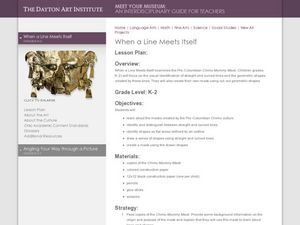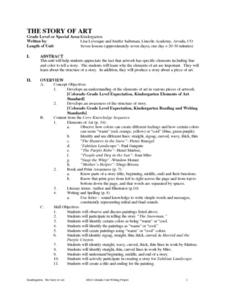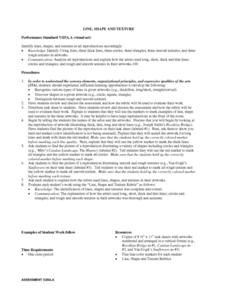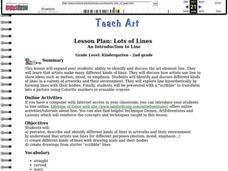CK-12 Foundation
Length of a Plane Curve
Challenge your class to use straight lines when estimating the length of a curve. An engaging interactive allows individuals to place line segments one after another along the arc. Learners determine that the more lines used, the better...
Curated OER
Making a Pinhole Camera
Students are introduced to the basic straight line pattern of travel that light takes. A cereal box and wax paper provide the pinhole camera that captures the light's inverted image. Shifting this pattern provides additional challenges.
Positively Autism
Cutting Practice — Different Lines
Use a cutting worksheet that has pupils cutting different types of lines including straight, zig zag, and curved lines.
Curated OER
Exploring and Using Shapes to Make a Dance
Second graders use their bodies to create various shapes to make a dance when given various music and beats. In this shapes and dance lesson plan, 2nd graders create lines, curves, twists, and angles with their bodies.
Curated OER
Line: a Geometric Exercise
Young scholars study the different types of lines and create a drawing demonstrating what they learned.
Radford University
Can I Create a Line/Curve of Best Fit to Model Water Drainage?
Learners collect data on the amount of water left in a bottle over time. They graph the data to determine whether the scatter plot shows a curved or straight relationship. Group members then determine an equation for the curve of best...
Curated OER
Lines of Symmetry
Students practice dance to divide the space or body shape into equal sections to create symmetry in dance. In this symmetry lesson, students practice symmetrical and asymmetrical movements in dance. Students participate in move and...
It's About Time
Curved Mirrors
Discover concave and convex mirrors using a laser light. Scholars experiment with real and virtual images before reading a handout and completing homework questions. Included extensions greatly benefit learners, so take...
Curated OER
When A Line Meets Itself
Students investigate the linear characteristics of cultural art. In this art analysis lesson, students discover the Pre-Columbian Chimu culture and the many masks they created. Students identify the different shapes and lines...
Curated OER
Contours, Curves & Lines
Students discover how straight lines and curves function in both art and the science of conservation tillage by building model "hills" and experimenting on them.
Curated OER
The Story of Art
Students canvass the important elements of art in the seven lessons of this unit. Story structure and in particular, color is perceived as essential to the development of the idea of a picture.
Curated OER
Everyday Heroes You Can Be One, Too
Students listen to a read aloud of Alan Baker's, White Rabbit's Color Book while identifying shapes and lines throughout the book. They use shapes and different types of lines to create a bunny of their own. They must use five shapes to...
Curated OER
Line, Shape, and Texture
Students are introduced to various types of artwork by various artists. In groups, they identify the lines and shapes used by the artist to create a specific texture. They write a paper of their observations and discuss them as a class.
Houghton Mifflin Harcourt
Unit 6 Math Vocabulary Cards (Grade 3)
A set of 49 math vocabulary cards ranges from angle to irregular polygon to parallel lines. Each sheet contains two cards: one with the word printed in bold text and the other with the definition.
Curated OER
Measuring for Perimeter
Third graders find the perimeter of a polygon. In this measurement lesson, 3rd graders use yardsticks to measure straight-lined objects to the nearest 1/2 inch. Student choose a "mystery object," find the perimeter, and record it on the...
Curated OER
Scientists Track the Rising Tide
In this tracking the rising tide worksheet, students use the data in a graph showing the seal level change versus time from 1900 to 2000 to answer 3 questions about the rising tides. Students determine the slope of a line drawn from 1920...
One Billion
Math, Age 3-5
Jump start children's math education with this fun basic skills resource. Offering dozens of different touch-and-swipe activities with colorful graphics, this program is perfect for all young learners.
Union County Vocational Technical Schools
Engineering Drawing
Knowing the basics of drafting allows individuals to create drawings that show all the views and measurements necessary to allow others to visualize the original object. Pupils gain experience by drawing three orthographic views of...
Curated OER
Creating Letter-shape Patterns
Help your budding writers become familiar with letter shapes using a pattern worksheet. They examine three patterns, tracing a dotted line to continue them to the end of the page. For each, they also draw the pattern freehand below. This...
Curated OER
Ice-Creamer Tracer
In this tracing an ice-cream cone learning exercise, students practice using fine motor skills to trace curved and straight lines. Students trace one picture.
Curated OER
Graphing and Analyzing
In this graphing and analyzing activity, 9th graders first state if each graph represents a linear or nonlinear relationship. Second, they create a difference table for each set of data presented and determine whether it represents a...
Inside Mathematics
Graphs (2006)
When told to describe a line, do your pupils list its color, length, and which side is high or low? Use a worksheet that engages scholars to properly label line graphs. It then requests two applied reasoning answers.
Curated OER
Straight and Curved Shapes Venn Diagram
In this math worksheet, students classify the shapes according to the correct category concerning having straight or curved sides.
Curated OER
Lots of Lines
Students see that artists make many different kinds of lines. They discuss how artists use line to show ideas such as motion, mood, or emphasis and identify different kinds of lines in a variety of artworks and their environment.

























